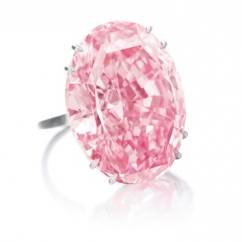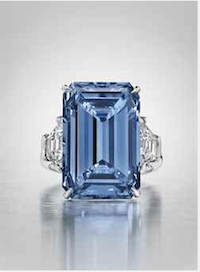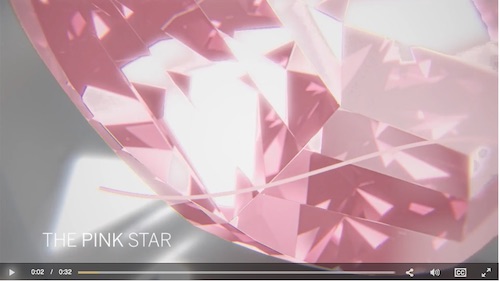Articles and News
How A $71.2 Million Diamond Could Be The Bargain Of The Century | July 05, 2017 (0 comments)

Las Vegas, NV—In April, the 59.60-carat Pink Star sold for $71.2 million at Sotheby’s. It was the largest-known fancy vivid pink diamond of that grade, and the largest—and most expensive—ever sold at auction, surpassing even the 14.62-ct Oppenheimer Blue diamond, which sold at Christie’s Geneva for $57.5 million in 2016. The Pink Star’s buyer, Chow Tai Fook—owner of the Hearts On Fire and Memoire brands—renamed it but hasn't yet announced what it plans to do with the stone.
But did Chow Tai Fook get a huge bargain on the most expensive diamond ever?
Russell Shor, GIA senior industry analyst, traces the diamond’s journey and explains why, even with a price tag topping $70 million, it still could be the bargain of the century.
De Beers mined the 132.5-carat rough stone in 1999 and sold it to the Steinmetz Group, who took two years to cut it into oval shape, with a yield of 45%. Named the Steinmetz Pink, it was unveiled in 2003 and exhibited at the Smithsonian Institution with seven of the world’s most extraordinary colored diamonds. In addition to the value derived from its color, it also is the largest internally flawless diamond ever found.
Four years ago, it came up for auction at Sotheby's in Geneva, Switzerland. Both the press and speculators were all over the stone, assuming it would go for a colossal amount of money. Indeed, it seemed sold for a whopping $83 million, to a New York-based dealer who named it the Pink Dream. But between the hammer fall of the auction and when it came time to sign the check, the dealer came up short on money to complete the sale. Sotheby’s, meanwhile, had guaranteed the seller a certain price, so they bought the stone six months later, in March 2014, for $70 million. And the stone sat in inventory for three years until this spring.
Aged inventory is nothing new for jewelers, though typically “mega-stones” are the only category of diamonds virtually guaranteed to retain their value at the very least, if not gain value. So how can this ultra-rare stone that sold for more than any other diamond still be a bargain?
Simple, explains Shor. It’s all in the per-carat price, and this stone averages out to a mere $1.2 million per carat.
“Compare that to the Graff Pink, which at 24.78 carats sold for $46 million, or $1.85 million per carat. That’s half a million plus more per carat than the Steinmetz Pink of the same grade.”
“The Oppenheimer Blue sold for $3.93 million per carat; a total of $57.5 million for an amazing 14.62-ct. stone, but it’s still not the per-carat record,” he continued. The Blue Moon, a fancy vivid blue that sold for $4.02 million per carat, or a total of $48.5 million, holds the record per-carat price.

The Oppenheimer Blue sold for more than three times the per-carat price of the Pink Star.
“So by that standard, the Pink Dream was a bargain,” said Shor. Had it lived up to the others on a price-per-carat basis, its hammer price would have been $150 million to $200 million total. By contrast, says Shor, the record for a [colorless] D-Flawless of any shape is $283,000 per carat.
To see a video of the Pink Star, click here or on the image below.
So why did this rarest of all rare diamonds sell for a lot less? It’s not because $71 million would exhaust the resources of a billionaire, says Shor. “Consider fine art. More than two dozen works of art have surpassed the 100 million mark. A painting in Cezanne’s The Card Players series sold for $276 million, to an individual, not a corporation. Picasso’s Les Femmes D'Alger sold for $179.4 million. The record price for artwork was $300 million for Willem de Kooning's Interchange.”
These are much higher prices than any diamonds have ever fetched, says Shor. And famed diamond dealer Laurence Graff once told this reporter that on a global level money never goes away, it just moves around.
The money is there. So why isn’t it going into gemstones?
Doug Gollan, author of Secrets Of Selling To The Super-Rich, suggests that the very thing that determines the value of a jewel--its gemological pedigree--might be what keeps it from reaching the kind of stratospheric prices seen in the art world. "The rich, being analytic, can compare jewelry by the multiple measurements of precious stones and metals, and then add on fantasy premiums for what something worn by Liz Taylor is 'worth,' while art is just totally fantasy money. The actual materials have no meltdown value so the value of a piece of art can be whatever the highest buyer dreams, without a reality check."
Shor has his own theory. “As more and more large diamonds are found, computer-guided lasers diminish loss in cutting. Conventional wisdom is that as the size of a diamond increases, so does the price per carat. But what we might see is a peak and then the price recedes or plateaus. I’m not sure if it's valid scientific statistic yet, but it's definitely a trend to watch.”
If so, we might be seeing a lot of large rough cut to increase price per carat instead of super-large stones, he says. “There’s no secret market for large gems, and bling in general is softening,” he said. Most mega-stones are bought for investment, not to wear, he says, and there are wide variations in prices even in the best of times. The market depends on competitive bidding, so if even one person drops out, the price of top stones is greatly reduced.
What this means to you. How can jewelers who might never even see, let alone sell, a stone worth seven figures relate all this? Easy, says Shor. And it’s also a good selling point when asked about man-made diamonds.
“All these gems are exceptionally rare and valuable. The smaller gems, like those in your showcases, are souvenirs of the great upheaval at the beginning of our Earth. They were formed with the earth, and all gemstones connect us to planet like nothing ever could. This is really what gemstones do.”








